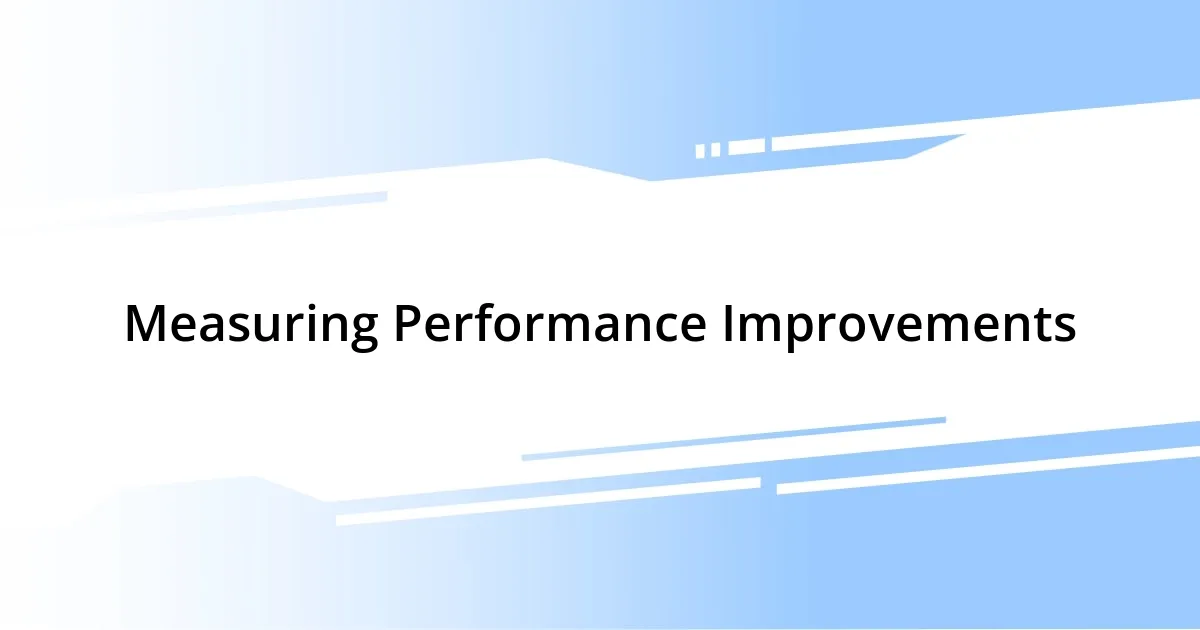Key takeaways:
- Understanding Ruby’s performance issues involves recognizing inefficiencies due to dynamic typing and garbage collection.
- Effective profiling with tools like StackProf and ruby-prof uncovers bottlenecks and aids in informed optimization decisions.
- Implementing efficient coding practices, such as leveraging built-in methods and clear modular design, enhances both performance and code readability.
- Caching mechanisms, including Redis and Rails’ built-in strategies, significantly improve application load times and resilience by storing precomputed results.

Understanding Ruby Performance Issues
When I first started working with Ruby, I was often frustrated by its performance. It’s easy to overlook that Ruby, being an interpreted language, can sometimes lag under heavy loads or complex algorithms. Have you ever found yourself staring at a slow-running script, wishing for a magic wand to speed things up?
One particular project sticks in my mind. I had written a Ruby script to process hundreds of thousands of records, only to watch it crawl as it handled the data one by one. It hit me then that inefficiencies in Ruby’s default behavior—like how it uses dynamic typing and garbage collection—could lead to unexpected slowdowns. These performance issues can be frustrating but understanding them is the first step toward optimization.
I’ve learned that certain constructs in Ruby, such as using blocks and iterators instead of traditional loops, can make a noticeable difference. Isn’t it fascinating how a slight shift in approach can lead to significant improvements? By embracing these Ruby quirks and nuances, I found not just solutions, but also a deeper appreciation for the language.

Identifying Bottlenecks in Code
When I was digging deeper into Ruby performance, I quickly realized that identifying bottlenecks is crucial. It’s like navigating a maze—sometimes you just need to pinpoint where the dead ends are. I remember using profiling tools like Ruby’s built-in Benchmark and the more advanced StackProf, which opened my eyes to which methods were taking an eternity to execute. There’s something incredibly satisfying about watching those numbers shift as you track down the slowest parts of your code.
Here are some techniques that proved valuable when I was hunting for bottlenecks:
- Profiling: Utilize tools like Benchmark or MiniProfiler to analyze your code’s performance.
- Logging: Incorporate detailed logging to trace the execution time of critical sections.
- Visual Tools: Use visual profilers, such as RubyMine or Rack Mini Profiler, to get a clearer picture of performance issues.
- Assess Complexity: Evaluate the time complexity of algorithms to spot inefficiencies.
- Database Queries: Monitor SQL queries to ensure they aren’t slowing down your application.
By taking these steps, I felt more empowered to tackle performance challenges head-on, turning what once felt overwhelming into a manageable puzzle.

Utilizing Profiling Tools Effectively
Utilizing profiling tools effectively can be a game-changer in improving your Ruby application’s performance. I recall a moment when I was deep into a side project and feeling frustrated by the sluggish response times. By leveraging profiling tools like stackprof, I discovered that a single method call was consuming nearly half of my application’s runtime. It’s such an enlightening experience to see the data unfold—suddenly, that intangible issue morphs into something tangible and actionable.
Another powerful tool that I found incredibly beneficial is the ruby-prof gem. It gave me a comprehensive look into memory allocation and method execution times. When I ran it on my project, I was amazed to discover that my frequent use of array concatenation was creating unnecessary overhead. By switching to more efficient alternatives, I managed to reduce processing time significantly. This kind of insight can really shift your understanding of how your code operates under the hood.
Having a solid grasp of profiling methods isn’t just beneficial; it’s essential. It allows you to make informed decisions rather than guesswork when optimizing your code. Each profiling tool provides unique insights, and by comparing their outputs, I found that my intuition about code performance was often off the mark. Here’s a quick comparison of some profiling tools I’ve used, and trust me, each one has its strengths:
| Tool | Description |
|---|---|
| Benchmark | Basic tool for measuring execution time of Ruby code snippets. |
| StackProf | Fast profiler that shows stack traces and is excellent for identifying bottlenecks. |
| ruby-prof | Comprehensive profiler that tracks memory usage and method calls, providing detailed breakdowns. |
| MiniProfiler | Visual tool for profiling web applications, showing database queries and request durations. |

Implementing Efficient Coding Practices
Implementing efficient coding practices has been a cornerstone of my journey to optimize Ruby performance. I vividly remember a project where I spent countless hours perfecting a function, only to realize later that I could have simplified it significantly by opting for Ruby’s built-in methods. The moment I embraced the power of native functions over custom implementations, I felt a weight lift off my shoulders. It’s incredible how much clearer the code becomes when we leverage the efficiency built right into the language.
One shift that had a massive impact on my coding style was adopting clear naming conventions and modular design. Initially, I was guilty of cramming too much logic into single methods, which tangled my code into a confusing web. When I started breaking things down into smaller, reusable functions, I noticed a dramatic improvement—not just in performance, but in readability as well. Don’t you find that when code is easier to read, it somehow feels lighter and less daunting? It’s a technique that has transformed my approach to coding.
Finally, I can’t stress enough the importance of collaboration and code reviews in this process. Engaging with my peers not only exposed me to new perspectives but also highlighted areas where I could refine my code. There were times when a simple suggestion from a colleague led to a more efficient algorithm or a cleaner implementation. It’s a reminder that coding doesn’t have to be a solitary journey; sharing ideas and insights elevates everyone involved. How often do we overlook the value of community in our coding practices? Embracing it has been a game-changer for me.

Leveraging Caching Mechanisms
When I first ventured into caching for my Ruby applications, I was amazed at the immediate impact it had on performance. I remember implementing Redis as a caching solution and witnessing a dramatic decrease in load times—it was like flipping a switch! Caching allows you to store the results of costly operations and retrieve them quickly, and believe me, when your app can serve data in milliseconds instead of seconds, it transforms user experience. How often do we underestimate the value of accessing precomputed results?
Another breakthrough for me was using Rails’ built-in caching strategies. The first time I integrated fragment caching into a view, I was astounded at how it lessened the strain on the database. Instead of rendering everything fresh for every request, I learned to identify pieces of data that could remain static for a bit. The satisfaction of watching the dashboard update with reduced queries was incredibly fulfilling! It was a tangible reminder that smart caching not only speeds up applications but also frees up resources for other processes. Isn’t it gratifying to see your work get rewarded in such an immediate way?
And let’s not forget about caching at the API level. Once, I had a project where external API calls were crippling performance. By introducing an internal cache for the responses, I didn’t just improve the response times; I ensured that my application could handle spikes in traffic gracefully. Looking back, it was eye-opening to realize that caching is not just about speeding things up; it’s about building resilience into my applications. What lessons will you take away from your caching endeavors?

Adopting Concurrency in Ruby
Diving into concurrency in Ruby was like unveiling a hidden layer of potential within my applications. I recall a project with heavy data processing where I felt the toll of waiting for tasks to complete sequentially. Introducing the Thread class felt like adding turbo to my engine—I was able to execute multiple processes at once. It was exhilarating to see tasks run in parallel, effectively utilizing resources and reducing overall execution time. Have you ever experienced that rush when your code performs better than expected?
The shift to concurrent programming also made me reconsider my approach to error handling. With multiple threads, the prospect of dealing with exceptions from various processes seemed daunting. I remember implementing a centralized error handling mechanism that caught exceptions from threads neatly. What a relief it was! Suddenly, I found that I could focus on optimizations rather than being bogged down by tracking a web of potential errors. Isn’t it rewarding when a slight adjustment leads to clarity in a complex landscape?
Looking back, one of the most valuable tools I stumbled upon was the `Concurrent Ruby` gem. When I first integrated it, I felt like I’d discovered a toolbox full of gadgets for my coding challenges. It simplified many concurrency patterns that once intimidated me, particularly with its thread pools and futures. Working with it was like having a reliable co-pilot in my coding journey, allowing me to focus on the bigger picture instead of getting lost in the weeds. Have you ever wondered how much more efficient your workflow could be with the right tools at your disposal? Trust me, the leap into concurrency has been a significant growth point in my Ruby adventures.

Measuring Performance Improvements
Measuring performance improvements in Ruby can sometimes feel like piecing together a puzzle. I vividly recall my first experience using benchmarking tools like Benchmark and Benchmark-ips to assess the execution time of various methods. It was astonishing to see hard data reflecting the efficiency gains I had achieved—like seeing your reflection in a clear lake rather than a foggy mirror. There’s something incredibly satisfying about quantifying your efforts in black and white.
I also learned the hard way that not all optimizations yield the same benefits. I remember an instance where I restructured a method for better efficiency, only to find it hardly moved the needle when I analyzed the results. The lesson here was invaluable: continual measurement is key. I began to consider performance optimization a cycle, not a one-off task. It instilled a mindset of relentless improvement—how many of us truly appreciate the journey as much as the destination?
Lastly, using tools like RubyProf helped me dive deep into where the bottlenecks resided. I enjoyed organizing the profiling results into charts to visualize the time spent on different parts of my application. It’s like being a detective; you get to uncover the culprits behind slow performance. Has there been a moment in your coding journey where insightful metrics changed your perspective? I can wholeheartedly say that these experiences have transformed how I approach problem-solving in Ruby—I now understand that measurement is the key to unlocking genuine improvement.














